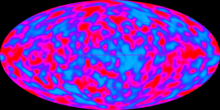John C. Mather

John Cromwell Mather (lahir pada 1946), adalah merupakan seorang ahli astrofiizik dan ahli kosmologi Amerika Syarikat.
Beliau merupakan seorang ahli astrofiizik veteran di NASA bertempat di Pusat Penerbangan Angkasa Goddard di Maryland dan professor "adjunct" fizik di University of Maryland, College Park. Beliau telah dianugerahkan Hadiah Nobel dalam Fizik 2006, berkongsi dengan George F. Smoot kerana "penemuan mereka terhadap bentuk jasad hitam dan anisotrofi of the latarbelakang sinaran gelombang mikro kosmik". Penemuan ini membantu mengukuhkan teori Big-bang alam semesta denan menggunakan satelit COBE (Cosmic Background Explorer) dan telah memulakan era "ketepatan kosmologi", merujuk kepada ahli kosmologi University of Chicago, Michael Turner. [1]
Biografi
[sunting | sunting sumber]Permulaan penyelidikan dan pendidikan
[sunting | sunting sumber]- 1968 B.A. (Physics), Swarthmore College
- 1974 Ph.D. (Physics), University of California, Berkeley
Penglibatan dalam COBE
[sunting | sunting sumber]
Kejayaan COBE adalah hasil kerja kumpulan yang melibatkan lebih daripada 1,000 penyelidik-penyelidik, jurutera-jurutera dan ahli-ahli yang lain. John Mather menyusun/ mengkoordinasi keseluruhan proses dan juga mempunyai tanggungjawab utama bagi eksperimen yang telah mendedahkan bentuk jasad hitam dalam sinaran gelombang mikro yang telah diukur oleh COBE. George Smoot juga mempunyai tanggungjawab mengukur variasi-variasi yang ekcil dalam suhu gelombang tersebut.[2].
He chronicled his team's work in a book for the general public. The book, The Very First Light: The True Inside Story of the Scientific Journey Back to the Dawn of the Universe [3] was co-written with John Boslough, and published in 1996.
Projek terkini
[sunting | sunting sumber]Anugerah
[sunting | sunting sumber]- Open Scholarship (honorary), Swarthmore, 1964-68
- William Lowell Putnam Mathematical Competition, 1967, 30th place nationwide
- NSF Fellowship and honorary Woodrow Wilson Fellowship 1968-70
- Hertz Foundation Fellowship, 1970-74
- John C. Lindsay Memorial Award (NASA-GSFC), 1990
- Rotary National Space Achievement Award, 1991
- National Air and Space Museum Trophy, 1991
- Aviation Week and Space Technology Laurels, 1992, for Space/Missiles
- Discover Magazine Technology Award finalist, 1993
- American Institute of Aeronautics and Astronautics Space Science Award, 1993
- Dannie Heineman Prize for Astrophysics, American Astronomical Society and American Institute of Physics, 1993 (presented Jan. 1994)
- Goddard Fellow, 1994, GSFC
- Honorary Doctor of Science Degree, Swarthmore College, 1994
- John Scott Award, City of Philadelphia, 1995
- Rumford Prize, American Academy of Arts and Sciences, 1996
- Fellow, American Physical Society, 1996
- Hall of Fame, Aviation Week and Space Technology, 1997
- Member, National Academy of Sciences, 1997
- Marc Aaronson Memorial Prize, 1998
- Member, American Academy of Arts and Sciences, 1998
- Benjamin Franklin Medal in Physics, Franklin Institute, 1999
- George W. Goddard Award, Society of Photo-Optical Instrumentation Engineers, 2005
- Cosmology Prize, with COBE Team, Peter Gruber Foundation, 2006
- Nobel Prize in Physics, 2006
Pautan luar
[sunting | sunting sumber]- Interview with John Mather in SPIE's oemagazine Diarkibkan 2006-10-18 di Wayback Machine
- Short biography at the Goddard Space Flight Center
- Berkeley lab article
Rujukan
[sunting | sunting sumber]- ^ Dennis Overbye (2006-10-03). "2 Americans Win Nobel Physics Prize". New York Times. Dicapai pada 2006-10-05. Italic or bold markup not allowed in:
|publisher=(bantuan) - ^ Press release: Pictures of a newborn Universe
- ^ The Very First Light: The True Inside Story of the Scientific Journey Back to the Dawn of the Universe, by John C. Mather and John Boslough, Basic Books edition (November 1998) ISBN 046501576X

